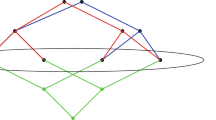Abstract
A complete weighted graph, \(G(X,\varGamma ,W)\), is considered. Let \(\tilde{X}\subset X\) be some subset of vertices and, by definition, a Steiner tree is any tree in the graph G such that the set of the tree vertices includes set \(\tilde{X}\). The Steiner tree problem consists of constructing the minimum-length Steiner tree in graph G, for a given subset of vertices \(\tilde{X}\) The effectively computable estimate of the minimal Steiner tree is obtained in terms of the mean value and the variance over the set of all Steiner trees. It is shown that in the space of the lengths of the graph edges, there exist some regions where the obtained estimate is better than the minimal spanning tree-based one.

Similar content being viewed by others
References
Brazil, M., Thomas, D. A., & Weng, J. F. (2004). Upper and lower bounds for the lengths of Steiner trees in 3-space. Geometriae Dedicata, 109, 107–119.
Cieslik, Dietmar. (2003). The Steiner ratio of several discrete metric spaces. Discrete Mathematics, 260, 189–196.
Du, D.-Z., Lu, B., Ngo, H., & Pardalos, P. M. (2001). Steiner tree problems. In C. Floudas & P. Pardalos (Eds.), Encyclopedia of optimization (Vol. 5, pp. 227–290). Dordrecht: Kluwer Academic Publishers.
Garey, M. R., Graham, R. L., & Johnson, D. S. (1976). Some NP-complete geometric problems. In Eighth annual symposium on theory of computing, pp 10-22.
Gilbert, E. N., & Pollak, H. O. (1968). Steiner minimal trees. SIAM Journal on Applied Mathematics, 16, 11–29.
Hardy, G. H., Littlewood, J. E., & Polya, G. (1952). Inequalities (2nd ed.). Cambridge: Cambridge University Press.
Hwang, F. K., Richards, D. S., & Winter, P. (1992). The Steiner tree problem. North-Holland: Elsevier.
Innami, N., Kim, B. H., Mashiko, Y., & Shiohama, K. (2010). The Steiner ratio conjecture of Gilbert-Pollak may still be open. Algorithmica, 57, 869–872.
Kirzhner, V., & Rublinecky, V. I. (1974). An upper limit for the traveling salesman minimal tour. In Proceeding low temperature physic institute “computing mathematics & Computers”, V 1974, pp 120–122 (in Russian).
Skiena, S. (1990). Implementing discrete mathematics: Combinatorics and graph theory with mathematica. Reading, MA: Addison-Wesley. p. 235.
Zaycev, I., Vayner, V., & Kirzhner, V. (1988). An estimate of the functional optimum in problems of connecting objects with a network. In Ukrainian Doklady, Series A (Vol. 8, pp. 71–74). (in Russian).
Author information
Authors and Affiliations
Corresponding author
Rights and permissions
About this article
Cite this article
Kirzhner, V., Volkovich, Z., Ravve, E. et al. An estimate of the objective function optimum for the network Steiner problem. Ann Oper Res 238, 315–328 (2016). https://doi.org/10.1007/s10479-015-2068-1
Published:
Issue Date:
DOI: https://doi.org/10.1007/s10479-015-2068-1




